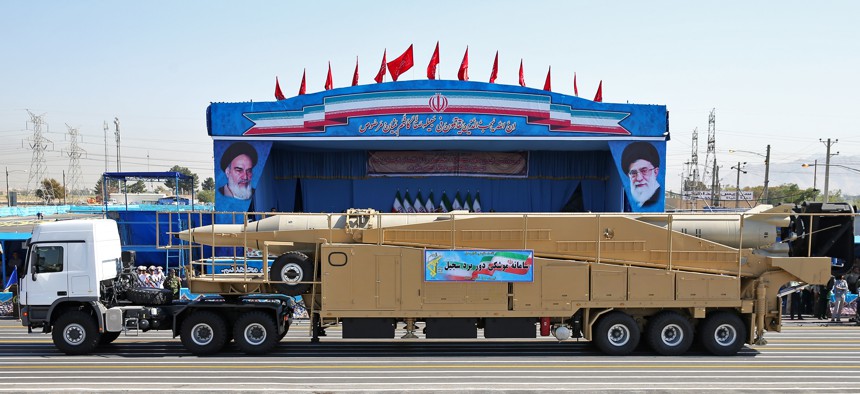
2016 photo of Iran's Sejjil, a surface-to-surface, a two-stage, solid-fuel ballistic missile, displayed by the Revolutionary Guard just outside Tehran. AP / Ebrahim Noroozi
Fixing The Iranian Missile Problem
It won’t be easy, but Europe and Washington should pressure Iran into suspending missile flight-testing.
President Donald Trump has hinted that his vision for improving the nuclear deal with Iran includes a prohibition on missile tests. “What kind of deal is it where you are allowed to test missiles all over the place?” he recently asked. Indeed, if both sides of the Atlantic are serious about stopping Iran from developing a deliverable nuclear weapon, they should push for a moratorium on nuclear-capable ballistic missile flight-tests. This will be no easy task, since Tehran is wedded to its missile program for strategic and ideological reasons.
Since the conclusion of the nuclear deal in July 2015, the Islamic Republic has launched as many as 23 ballistic missiles. The U.S. intelligence community has repeatedly affirmed that a ballistic missile would serve as the most likely delivery vehicle for an Iranian nuclear weapon. Iran should therefore not be permitted to perfect this weapon.
At present, it is unknown whether a missile-testing prohibition will be included in the trans-Atlantic “fix.”
From what can be pieced together from recent reporting, the “fix” appears to take a two-track approach. The first aims to prevent Iran from developing intercontinental ballistic missiles, or ICBMs, by capping its missile ranges at 2,000 kilometers. Little is known about the second track, other than its intent to focus on Iran’s development and proliferation of shorter-range systems.
While an agreement to prevent an Iranian ICBM has value, Iran does not yet have a functioning ICBM. Instead, it has a diverse arsenal of short and medium-range ballistic missiles, the latter of which are all capable of carrying a nuclear warhead. This is the immediate threat.
By focusing on a 2,000-kilometer cap, America would be shielding Europe while forsaking the entire Middle East. Although Iranian officials have previously floated a 2,000-kilometer upper limit for their missiles, this is frequently followed-up with an attestation that the targets they wish to threaten fall within that range. And if desired, they could move to begin targeting Europe, which lies beyond that range.
Only the strongest multilateral sanctions on Iran’s domestic missile production networks will change the regime’s calculus about these weapons. These penalties should include America’s most potent sanctions, such as those that were suspended under the 2015 deal.
Ballistic missile tests allow Iran to show off military muscle and learn about the readiness and reliability of their arsenal. Iranian officials learned the value of missiles during the 1980-1988 Iran-Iraq War, a conflict they call “the holy defense.” Midway through the conflict, Iran procured Scuds to retaliate against Saddam Hussein and establish deterrence. Looking back now, officials believe that if their antebellum arsenal had contained such missiles, “war would not have broken out.”
Since that time, these weapons have been a source of national pride for Iran’s Islamic government and serve as physical manifestations of the regime’s ideology, such as self-sufficiency and anti-Semitism. In March 2016, Iran tested a homemade nuclear-capable ballistic missile bearing the genocidal slogan “Israel must be wiped out.”
Moreover, for over two decades ballistic missiles have overtaken the county’s dated air force as the main weapon employed to project power beyond its borders. When Tehran is confident that it can deter threats to its homeland, it becomes increasingly likely that it will pursue its agenda of destabilizing adversary governments abroad. Tough sanctions can help chip away at this confidence.
Iranian officials habitually claim that they will never negotiate over missiles, much as they did with uranium enrichment. But over time and when confronted with an international consensus and robust economic pressure, that position softened. So too, could this one. That is why a multi-party agreement over how to phase in sanctions in response to any renewed Iranian missile activity is sorely needed. Regardless of what Trump decides, Iran’s missiles are slated to remain a problem. The solution remains patient, dedicated, and creative coercive diplomacy from both sides of the Atlantic to attain a prohibition on missile tests.



